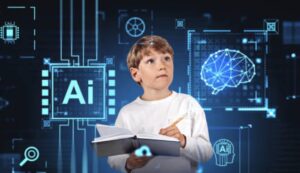[accordion]
[item title=”David Brown’s Presentation – An Outstanding Computing Curriculum”]
[embeddoc url=”https://technologyforlearners.com/wp-content/uploads/2015/03/Barefoot-conference-computing-and-e-safety-in-schools-Jul-11-14.pdf”]
[/item]
[/accordion]
As a computing coordinator, I am always looking for useful ideas to enhance the computing curriculum. One of the best online resources I refer to is The Barefoot Computing project, which is an initiative in England to help teachers to teach the computer science elements of the new primary computing curriculum. Funded by the Department for Education and run by the British Computing Society, Barefoot Computing provides some excellent free teaching resources to help enhance computing lessons.
Ofsted’s National Lead Inspector for Computing, David Brown, delivered an extremely useful presentation at the launch event for the Barefoot Computing project last year. Although I work internationally (and don’t need to worry about Ofsted), I feel that the information provided is relevant to anyone serious about computing education in schools. David shared his advice about what Ofsted expects from schools delivering the computing curriculum, and this advice is divided across four areas:
pupils’ achievement
teaching
the computing curriculum
leadership
These are also the general areas evaluated during an Ofsted inspection to assess the overall effectiveness of a school. I have paraphrased this advice in condensed form with my own reflections underneath.
Achievement in Computing:
– pupils demonstrate excellent understanding of important concepts in all three strands of the computing curriculum and can solve challenging problems
– pupils make highly effective use of a wide range of age appropriate hardware and software
– pupils show positive attitudes towards the subject and working constructively with others
– pupils show high levels of originality, imagination, creativity and innovation in their understanding and application of skills in computing
Seymour Papert developed the idea that the best way to construct knowledge and understanding, is through the construction of something shareable, outside of a student’s head. In other words, when pupils are consciously engaged in making things for others, learning happens most effectively. The collaborative and sharing functionality of the web certainly makes this very easy. Pupils can now use software like Scratch or Google Apps for Education for example, to create their own programs and digital content, and then share this with the rest of the world. This interaction made possible is probably the greatest benefit of the Web for educational use. This is exciting because it increases the potential for students to achieve greater levels of success than would otherwise be the case.
Teaching in Computing:
– it is informed by excellent subject knowledge and understanding of developments in computing pedagogy
-teachers have a high level of specialist knowledge and facilitate active learning in computing, which ensures pupils’ achievement
– it is rooted in the development of pupils’ understanding of important concepts; it enables pupils to make connections between individual topics and to see the ‘big picture’
– lessons address pupils’ misconceptions very effectively; teachers’ responses to pupils’ questions are accurate and highly effective in stimulating further thought
– teachers communicate high expectations, enthusiasm and passion about computing to pupils; they challenge and inspire pupils to produce the best work they can
– teachers use a very wide range of innovative and imaginative resources and teaching strategies to stimulate pupils’ active participation in their learning
One of the most effective teaching interventions identified by the Education Endowment Foundation (EEF) is feedback. Digital technologies certainly facilitate more opportunities for feedback. Feedback given to pupils who post their work online for instance, provides scaffolding in which they can build on their knowledge base. In this way, learners work within what Vygotsky (1978) would call their ‘zone of proximal development’. (This dynamic, incidentally, is at the heart of a social constructivist approach to teaching and learning). Computers of course, can also provide immediate feedback. In programming, there is a very tight feedback loop – it’s usually obvious whether the code runs as it should do or not. Encouraging learners to grapple with bugs in code (rather than solving the problem for them) can be a very effective way to help them develop their computational thinking.
The Computing Curriculum:
– an imaginative and stimulating curriculum is designed to ensure learning for all pupils
– the curriculum is broad and balanced with all three computing strands covered well
– the contexts in which computing is taught are relevant to pupils’ lives
– links with other subjects in the school are productive in strengthening pupils’ learning in computing
– pupils are expected to use their computing knowledge, skills and understanding in realistic and challenging situations
– pupils’ have comprehensive knowledge and understanding of how to stay safe when using new technologies
– rigorous curriculum planning ensures the subject makes an outstanding contribution to pupils’ spiritual, moral, social and cultural development.
Most of the old ICT curriculum is still present in the new computing curriculum. One of the strengths of the former curriculum was the creative, practical projects that pupils could take on. As highlighted in David’s advice, this is something that we can improve upon with the new curriculum, which includes a lot more rigour.
Leadership of Computing:
– leadership is informed by a high level of subject expertise and vision that has a clear impact on the performance of teachers and the learning outcomes for pupils
– there is a strong track record of innovation in computing
– subject leadership inspires confidence and whole-hearted commitment from pupils and colleagues
– continuing professional development is well-targeted and thoroughly evaluated for its impact; it includes up-to-date training for teaching staff
– computing has a very high profile in the life of the school and is at the cutting edge of initiatives to raise pupil progress
– access to computing equipment is outstanding, and the school is likely to have promoted the use of mobile technologies; the computing infrastructure enables pupils and staff to have very good access to their work and to the school’s learning resources at all times, and contributes to pupils’
– there is an age-appropriate e-safety curriculum that is flexible, relevant and engages pupils’ interest; that is used to promote e-safety through teaching pupils how to stay safe, how to protect themselves from harm and how to take responsibility for their own and others’ safety
– rigorous e-safety policies and procedures are in place, written in plain English, contributed to by the whole school and updated regularly.
The key here, I would say, is for leadership to provide professional development opportunities to improve the confidence and expertise of staff delivering computing lessons. In doing so, computing can hold a very high profile in the school and be more likely to benefit from proper policies and procedures in place.



